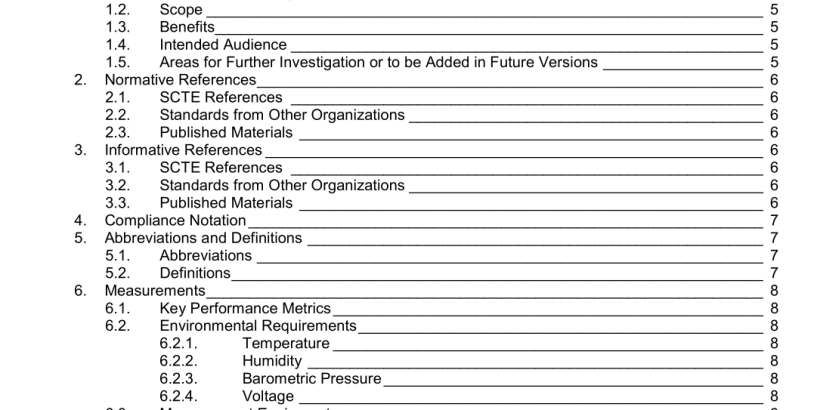ANSI SCTE 231-2016 pdf download.General Test Procedures for Evaluation of Energy Efficiency Metrics and in Support of Functional Density Metrics
1.1. Executive Summary
A series of SCTE documents are being created to provide the cable operator with standard references for determining how well a piece of rack or shelf equipment performs in terms of minimizing the power required to do its particular job. In addition, the standards provide the means to quantify the amount of useful work the equipment provides per physical space. This document supports the series of supplemental standards by providing a common set of testing procedures and methodologies to be used for evaluating the power consumption metrics defined by those standards.
1.2. Scope
Cable operator networks are large expansive networks that involve hundreds if not thousands of miles of coaxial or fiber cable powered by power supplies in the outside plant and connecting customers to critical infrastructure facilities such as hubs, headends, data centers, regional, and national distribution datacenters. In these facilities is a vast array of equipment responsible for the production and support of the cable operator’s products and services such as voice, video, data, home automation and security, and Wi-Fi. The importance of powering all of these devices in the critical facilities is ever increasing as the customer expectation is for 100% availability due to the critical nature of the services being provided to business and residential customers. Standard methodologies are needed to measure the energy consumption for the various network element classes as well as measuring the density of hardware to meet the needs of optimizing critical space.
This document covers the general test procedures that are common to all equipment types and specifies the environmental conditions for evaluating cable equipment energy efficiency metrics. Expectations of measurement equipment as well as guidelines on the recording of results are also covered. This standard will be included as a normative reference in each supplemental standard in the series covering metrics and specific test procedures for the various equipment types. The requirements in this document are applicable to all equipment types unless superseded by that equipment type’s supplemental SCTE standard.
1.3. Benefits
This standard defines general testing configuration and procedures in support of energy-specific performance metrics based on service features that are inherent to the type of equipment. This standard will contribute to improve the overall energy footprint by enabling engineering driven decisions that reduce energy consumption at the source of power consumption.
6.7. Test Configuration
The following has been adapted from [ATIS-0600015.2013] – section 5.7: Equipment under test (EUT) with multiple power connections (including redundant connections) shall have all feeds connected, and the power flow from all feeds shall be summed to obtain total system power. Within this document, the typical environment in a cable facility has an ambient temperature as specified in section 6.2.1. The energy consumed by fans may be higher when operating at this temperature range than at lower temperatures. To capture this potential higher energy consumption, the EUT shall be tested in a thermally controlled environment (for example, a thermal chamber) of no less than the low end of the temperature range specified in section 6.2.1. Traffic shall flow throughout the system and shall exercise the set of features and functions defined in the supplemental standard for the specific type of equipment. Traffic parameters shall also be defined in each supplemental standard.
The equipment vendor will choose the set of hardware and software components comprising the system being submitted for testing. In general, these components can be a mixture of hardware versions and software versions. However, from the standpoint of power consumption characteristics, the vendor will deem a particular system definition as a product generation. A product generation definition date, representing the date this product generation was available for power consumption characteristic testing, shall be identified by the vendor. In equipment-specific supplemental standards where the applicable test configuration scenarios are dependent on a time range (e.g. 2015-2017), the scenario(s) shall be determined based on the product generation definition date. Note that the product generation definition date may apply even if hardware or software components are included in the tested system that were introduced by the vendor prior to that date. The system definition may be amended to include new hardware and software components that do not significantly affect the power consumption characteristics. These may include but are not limited to obsolete parts replacement, defect fixes, and/or software updates that apply to the same product generation and do not change the product generation definition date.ANSI SCTE 231-2016 pdf download
